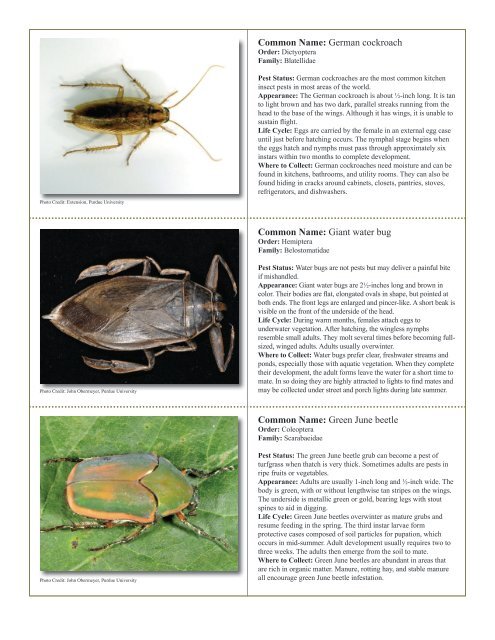to download pdf - Purdue Extension Entomology - Purdue University
to download pdf - Purdue Extension Entomology - Purdue University
to download pdf - Purdue Extension Entomology - Purdue University
Create successful ePaper yourself
Turn your PDF publications into a flip-book with our unique Google optimized e-Paper software.
Common Name: German cockroach<br />
Order: Dictyoptera<br />
Family: Blatellidae<br />
Pho<strong>to</strong> Credit: <strong>Extension</strong>, <strong>Purdue</strong> <strong>University</strong><br />
Pest Status: German cockroaches are the most common kitchen<br />
insect pests in most areas of the world.<br />
Appearance: The German cockroach is about ½-inch long. It is tan<br />
<strong>to</strong> light brown and has two dark, parallel streaks running from the<br />
head <strong>to</strong> the base of the wings. Although it has wings, it is unable <strong>to</strong><br />
sustain flight.<br />
Life Cycle: Eggs are carried by the female in an external egg case<br />
until just before hatching occurs. The nymphal stage begins when<br />
the eggs hatch and nymphs must pass through approximately six<br />
instars within two months <strong>to</strong> complete development.<br />
Where <strong>to</strong> Collect: German cockroaches need moisture and can be<br />
found in kitchens, bathrooms, and utility rooms. They can also be<br />
found hiding in cracks around cabinets, closets, pantries, s<strong>to</strong>ves,<br />
refrigera<strong>to</strong>rs, and dishwashers.<br />
Common Name: Giant water bug<br />
Order: Hemiptera<br />
Family: Belos<strong>to</strong>matidae<br />
Pho<strong>to</strong> Credit: John Obermeyer, <strong>Purdue</strong> <strong>University</strong><br />
Pest Status: Water bugs are not pests but may deliver a painful bite<br />
if mishandled.<br />
Appearance: Giant water bugs are 2½-inches long and brown in<br />
color. Their bodies are flat, elongated ovals in shape, but pointed at<br />
both ends. The front legs are enlarged and pincer-like. A short beak is<br />
visible on the front of the underside of the head.<br />
Life Cycle: During warm months, females attach eggs <strong>to</strong><br />
underwater vegetation. After hatching, the wingless nymphs<br />
resemble small adults. They molt several times before becoming fullsized,<br />
winged adults. Adults usually overwinter.<br />
Where <strong>to</strong> Collect: Water bugs prefer clear, freshwater streams and<br />
ponds, especially those with aquatic vegetation. When they complete<br />
their development, the adult forms leave the water for a short time <strong>to</strong><br />
mate. In so doing they are highly attracted <strong>to</strong> lights <strong>to</strong> find mates and<br />
may be collected under street and porch lights during late summer.<br />
Common Name: Green June beetle<br />
Order: Coleoptera<br />
Family: Scarabaeidae<br />
Pho<strong>to</strong> Credit: John Obermeyer, <strong>Purdue</strong> <strong>University</strong><br />
Pest Status: The green June beetle grub can become a pest of<br />
turfgrass when thatch is very thick. Sometimes adults are pests in<br />
ripe fruits or vegetables.<br />
Appearance: Adults are usually 1-inch long and ½-inch wide. The<br />
body is green, with or without lengthwise tan stripes on the wings.<br />
The underside is metallic green or gold, bearing legs with s<strong>to</strong>ut<br />
spines <strong>to</strong> aid in digging.<br />
Life Cycle: Green June beetles overwinter as mature grubs and<br />
resume feeding in the spring. The third instar larvae form<br />
protective cases composed of soil particles for pupation, which<br />
occurs in mid-summer. Adult development usually requires two <strong>to</strong><br />
three weeks. The adults then emerge from the soil <strong>to</strong> mate.<br />
Where <strong>to</strong> Collect: Green June beetles are abundant in areas that<br />
are rich in organic matter. Manure, rotting hay, and stable manure<br />
all encourage green June beetle infestation.
















